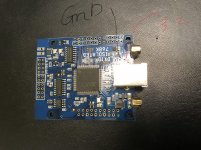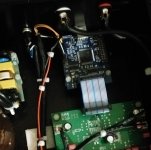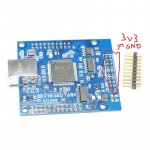Hello,
I finally took the time to look into this and got multi-channel DSD (64) to work on the combo XMOS board + ES9016 board.
I got inspiration from multichannel native DSD - Page 2 - XMOS embedded processors. Heart of XMOS technology, XCore.com
Feel free to ask for details if interested (although my implementation is not perfect).
Y.
Hey sebbersund,
I would love to flash my multichannel diyinhk board to support multichannel DSD. Would you be willing to share your firmware ? (for perdonal use of course)
best
Pepe
Hey sebbersund,
I would love to flash my multichannel diyinhk board to support multichannel DSD. Would you be willing to share your firmware ? (for perdonal use of course)
best
Pepe
PM'ed
Hello!
I have this board but the Isolated version, and I am confused. The description is saying that it only need 3.3V by X2 and Ground on the 20 Pins output with >100mA. But then I put in 3.3V with 200mA, and I only have noises with some music ?
Customer support says the module need another external supply on the un-clean side, or computer side ? Then where do I supply the power to ? And what is the current draw for this ? Please help. Thank you
The block diagram is showing Optional ?
Isolated XMOS 768kHz DXD DSD512(DSD1024) high-quality USB to I2S/DSD PCB - DIYINHK
I have this board but the Isolated version, and I am confused. The description is saying that it only need 3.3V by X2 and Ground on the 20 Pins output with >100mA. But then I put in 3.3V with 200mA, and I only have noises with some music ?
Customer support says the module need another external supply on the un-clean side, or computer side ? Then where do I supply the power to ? And what is the current draw for this ? Please help. Thank you
The block diagram is showing Optional ?
Isolated XMOS 768kHz DXD DSD512(DSD1024) high-quality USB to I2S/DSD PCB - DIYINHK
I'm afraid that I don't have this board, I have the multichannel one, and it's very different.
Looking at this one's documentation, I see hints that the "dirty" side is powered by the USB port so no external power is needed. The "clean" side does need power though, otherwise the board won't power on.
So it should work with external power applied just to the "clean" side.
If you're only hearing noise and some music, double check your I2S wiring. You might have swapped one of the cables.
Looking at this one's documentation, I see hints that the "dirty" side is powered by the USB port so no external power is needed. The "clean" side does need power though, otherwise the board won't power on.
So it should work with external power applied just to the "clean" side.
If you're only hearing noise and some music, double check your I2S wiring. You might have swapped one of the cables.
Is this the correct pins out for the PS into the computer side ? How much current will it draw ?
3.3v you bring it back to the first 2 pin or there is the connection of the screen Oled, but normally on the side of the Xmos without display the power of the USB is enough! But if your no display you only need to supply 3.3v the side dac side to feed the insulator, no need to feed Xmos side its alone by the usb. 200ma it must not be enough for me it takes at least 500ma at least, I measured but I remember more! This version requires a lot of current ...
Attachments
Last edited:
@Dimdim:
Thanks for following up and clarifying ;-)
Cheers,
Jesper
I'm afraid that I don't have this board, I have the multichannel one, and it's very different.
Thanks for following up and clarifying ;-)
Cheers,
Jesper
I also received the updated firmware from sebber for multichannel dsd, wondering if my multichannel usb-to-i2s is capable of 4ch dsd128 playback in DoP? I know sebber has mentioned getting only dsd64 working? Is this a limitation with the xmos xcore 200 hardware, or DoP or USB Audio class 2.0?
Well, I think that I was able to answer these by reading a bit more about DSD over PCM.
Seems that if the USB to i2s can handle DSD256 native, which my multichannel board states it can, then its DoP should be half of that or DSD128, This is per connection, so for my multichannel board I should get 6 channels of DoP DSD128. If Sebber is only getting DSD64, then I think it needs to be addressed elsewhere in his system or it is something in the firmware? I will test this soon and post what my system is capable of doing with this board.
Seems that if the USB to i2s can handle DSD256 native, which my multichannel board states it can, then its DoP should be half of that or DSD128, This is per connection, so for my multichannel board I should get 6 channels of DoP DSD128. If Sebber is only getting DSD64, then I think it needs to be addressed elsewhere in his system or it is something in the firmware? I will test this soon and post what my system is capable of doing with this board.
What DIYinhk boards would I need to assemble a high resolution DAC that could be compared in audio quality to ready made DACs?
Part of the system would be an isolated DSD 768KHz DSD like this one:
Isolated XMOS 768kHz DXD DSD512(DSD1024) high-quality USB to I2S/DSD PCB - DIYINHK
Picking the best DAC for that, which can handle coaxial and optical options too, is the following question. Which DAC board would that be?
Then I would need some way to select the inputs and show up on the case front.
And finally a very low noise linear power supply, something similar to this:
0.8uV Ultralow noise DAC power supply regulator 3.3/5/7V 1.5A*x2 - DIYINHK
One thing I like on DIYinhk modules is that they allow for separate supplies, if you want that, for every stage.
And last but not least a metal box to hold all this.
Has someone assembled something similar to this?
Part of the system would be an isolated DSD 768KHz DSD like this one:
Isolated XMOS 768kHz DXD DSD512(DSD1024) high-quality USB to I2S/DSD PCB - DIYINHK
Picking the best DAC for that, which can handle coaxial and optical options too, is the following question. Which DAC board would that be?
Then I would need some way to select the inputs and show up on the case front.
And finally a very low noise linear power supply, something similar to this:
0.8uV Ultralow noise DAC power supply regulator 3.3/5/7V 1.5A*x2 - DIYINHK
One thing I like on DIYinhk modules is that they allow for separate supplies, if you want that, for every stage.
And last but not least a metal box to hold all this.
Has someone assembled something similar to this?
I made a more complete boards list of what I think I would need to assemble this multi-input high resolution DAC:
DAC:
ES9038PRO XMOS DSD DXD 768kHz USB DAC with Bit-perfect volume control and SPDIF input - DIYINHK
DSD:
Isolated XMOS DSD DXD 384kHz high-quality USB to I2S/DSD PCB with ultralow noise regulator - DIYINHK
Power supply:
0.8uV Ultralow noise DAC power supply regulator 3.3/5/7V 1.5A*x2 - DIYINHK
I2S interface:
FIFO Reclock Jitter Eliminator - DIYINHK
I'm not sure why or what for would I need this:
1.3"OLED and rotary encoder volume control PCB - DIYINHK
No idea how I would select the inputs between DSD, coaxial and optical. That's something I might ask DUYinhk.
Basic bill till now: $230.
What else would I need or what is not necessary?
How do I select between input sources: DSD, coaxial and optical?
What case might hold all these boards?
I'm planning on a separate box for the transformer, to keep noise low.
DAC:
ES9038PRO XMOS DSD DXD 768kHz USB DAC with Bit-perfect volume control and SPDIF input - DIYINHK
DSD:
Isolated XMOS DSD DXD 384kHz high-quality USB to I2S/DSD PCB with ultralow noise regulator - DIYINHK
Power supply:
0.8uV Ultralow noise DAC power supply regulator 3.3/5/7V 1.5A*x2 - DIYINHK
I2S interface:
FIFO Reclock Jitter Eliminator - DIYINHK
I'm not sure why or what for would I need this:
1.3"OLED and rotary encoder volume control PCB - DIYINHK
No idea how I would select the inputs between DSD, coaxial and optical. That's something I might ask DUYinhk.
Basic bill till now: $230.
What else would I need or what is not necessary?
How do I select between input sources: DSD, coaxial and optical?
What case might hold all these boards?
I'm planning on a separate box for the transformer, to keep noise low.
This one (XMOS Multichannel high-quality USB to/from I2S/DSD SPDIF PCB - DIYINHK) is supposed to support ADC and DAC, but there is a trade-off between sampling frequency and number of channels:
384k 6ch out 4ch in + SPDIF out
192k 8ch out 8ch in + SPDIF out
If it possible to have 32 bit on output and 24 on input?
Why the change from Type 'B' to Type 'C' USB connector ? The type 'C' are very fragile especially the surface mount variety which eventually peels the copper trace off the board after sufficient movement of the connector. The new Type 'B' adaptor you offer is not very robust either and just flaps about in the breeze. Can you offer the original board with the Type 'B' connector directly soldered onto the board ?


Or USB 3. USB 3 would be a much better alternative to USB-C, and adapters are easy to find for USB 2.0 cables. I agree USB-C was not the best choice. And there are a lot of poor quality USB-C cables out there due to the cell phone market. You are also more likely to have a USB 3 output on PCs now than USB 2 or USB-C, and the cables are much more robust, as well as capable of greater power/data of course.
Last edited:
Or USB 3. USB 3 would be a much better alternative to USB-C, and adapters are easy to find for USB 2.0 cables. I agree USB-C was not the best choice. And there are a lot of poor quality USB-C cables out there due to the cell phone market. You are also more likely to have a USB 3 output on PCs now than USB 2 or USB-C, and the cables are much more robust, as well as capable of greater power/data of course.
The USB-B connector is much more robust than the surface mounted C connector. The latter eventually peels off the board after a bit of use. I had a tablet with this type of connector and it didn't take long for it to fail. The through-hole version of this part would be a better option
most multichannel support 32 bit.(amanero, minidsp, somo solutions from Russia). But DIYINHK 24 bit only. i need 32 bit 192 2 in 2 out only. and it not support.
I i prepair specal adc in mono mode for signal check(6 layer pcb) with snr more than 144. now i need to take another.why it cost in the same prise but have bad parameters?
I i prepair specal adc in mono mode for signal check(6 layer pcb) with snr more than 144. now i need to take another.why it cost in the same prise but have bad parameters?
- Home
- Vendor's Bazaar
- diyinhk Store


